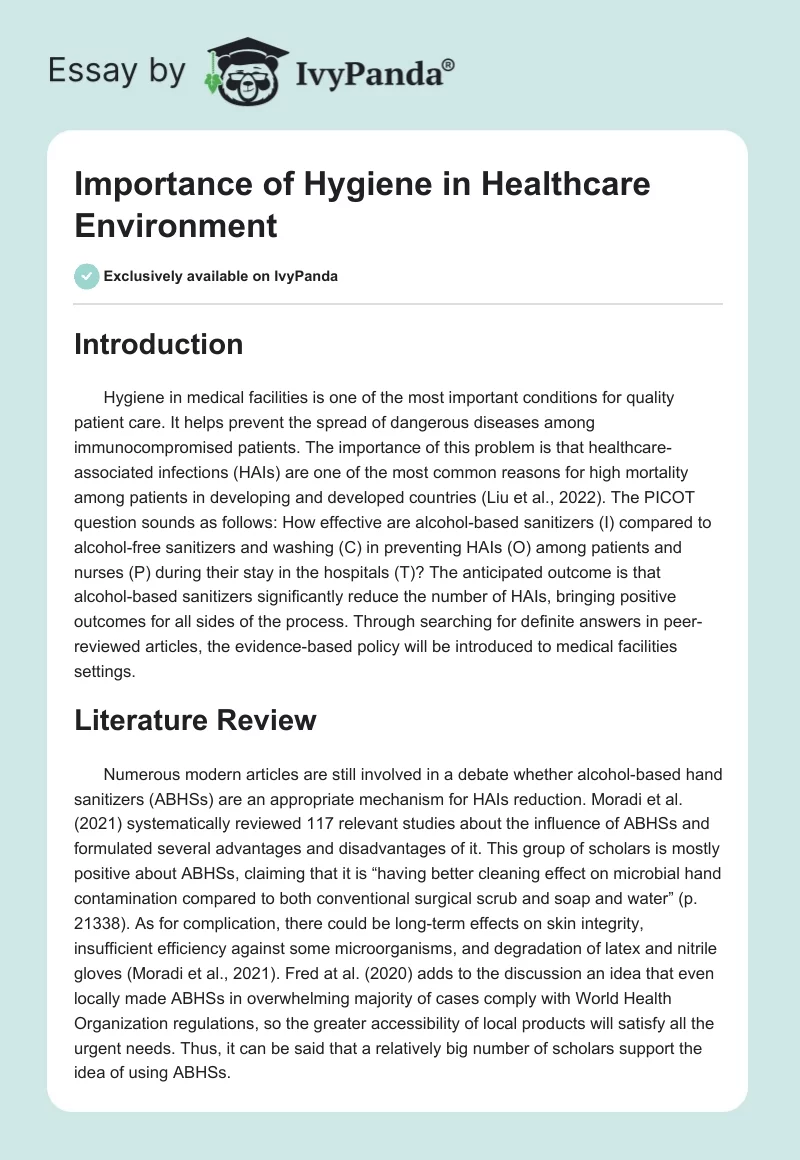Introduction
Hygiene in medical facilities is one of the most important conditions for quality patient care. It helps prevent the spread of dangerous diseases among immunocompromised patients. The importance of this problem is that healthcare-associated infections (HAIs) are one of the most common reasons for high mortality among patients in developing and developed countries (Liu et al., 2022).
The PICOT question sounds as follows: How effective are alcohol-based sanitizers (I) compared to alcohol-free sanitizers and washing (C) in preventing HAIs (O) among patients and nurses (P) during their stay in the hospitals (T)? The anticipated outcome is that alcohol-based sanitizers significantly reduce the number of HAIs, bringing positive outcomes for all sides of the process. Through searching for definite answers in peer-reviewed articles, the evidence-based policy will be introduced to medical facilities settings.
Literature Review
Numerous modern articles are still involved in a debate whether alcohol-based hand sanitizers (ABHSs) are an appropriate mechanism for HAIs reduction. Moradi et al. (2021) systematically reviewed 117 relevant studies about the influence of ABHSs and formulated several advantages and disadvantages of it. This group of scholars is mostly positive about ABHSs, claiming that it is “having better cleaning effect on microbial hand contamination compared to both conventional surgical scrub and soap and water” (p. 21338). As for complication, there could be long-term effects on skin integrity, insufficient efficiency against some microorganisms, and degradation of latex and nitrile gloves (Moradi et al., 2021). Fred at al. (2020) adds to the discussion an idea that even locally made ABHSs in overwhelming majority of cases comply with World Health Organization regulations, so the greater accessibility of local products will satisfy all the urgent needs. Thus, it can be said that a relatively big number of scholars support the idea of using ABHSs.
Nevertheless, some scholars call for alternative ways for preventing HAIs. Abo-zeid et al. (2022) warns about the number of adverse effects, such as skin sensitivity, drying, and cracks. They found that rhamnolipid nano-micelles solution has the same impact on HAIs but brings less harmful side effects (Abo-zeid et al., 2022). This solution is possible if there is an opportunity of cost-effective and extensive manufacturing of rhamnolipids (Abo-zeid et al., 2022). Lastly, the study by Akuoko et al. (2019) showed that some healthcare facilities may use agents with low amounts of alcohol which results in a dramatic decrease in efficiency. For example, it was argued that an agent with 61% to 75% of alcohol was of the same efficiency as hand washing with antiseptic soap (Akuoko et al., 2019). Although in developing countries even such ABHSs will bring strongly positive effects, in developed countries some clear certification procedures are desirable.
Proposed Evidence-Based Practice Change
The proposed four articles clarify the relevance of the PICOT question. Two articles showed the positive aspects related to ABHSs, while other two argued for some complexities and drawbacks of this approach. Critics show that although ABHSs are recognized as effective in comparison to alcohol-free sanitizers and washing, there are some issues related to the amount of alcohol in agents. In addition, there are some new alternative ways to sanitize as rhamnolipid nano-micelles. Thus, all these articles address the nursing practice problem of HAIs cases and provide some feasible solutions to it. The evidence based solution is centered on conditions surrounding a particular healthcare facility. If it is possible to create an effective production of rhamnolipids, then one should stop at an alternative to sanitizers with alcohol. Otherwise, it is required to constantly maintain the quality of the agent in order to avoid loss of effectiveness. Thus, the answer to the PICOT question is generally “yes”, so with some above clarifications, ABHSs may be used in any healthcare facility.
Conclusion
To sum up, the PICOT question works as a guiding pattern for creating practical solutions to the nursing care problem. This technique of creating definite questions through PICOT is used in many modern research on acute healthcare problems (Beckett et al., 2021). In this paper, the problem of HAIs was considered through the lens of seeking proper sanitizer. It was argued that with some limitations ABHSs still are regarded as the most effective way to ensure hygiene.
References
Abo-Zeid, Y., Bakkar, M. R., Elkhouly, G. E., Raya, N. R., & Zaafar, D. (2022). Rhamnolipid Nano-Micelles versus Alcohol-Based Hand Sanitizer: A Comparative Study for Antibacterial Activity against Hospital-Acquired Infections and Toxicity Concerns. Antibiotics, 11(5), 1-22.
Beckett, C. D., Zadvinskis, I. M., Dean, J., Iseler, J., Powell, J. M., & Buck‐Maxwell, B. (2021). An integrative review of team nursing and delegation: implications for nurse staffing during COVID‐19. Worldviews on Evidence‐Based Nursing, 18(4), 251-260.
Fred, T., Sophia, K., Alex, S., Emmanuel, B., Tom, L., & Lucas, A. (2020). Comparison of antibacterial efficacy of locally produced alcohol based hand sanitizer and commonly available commercial hand sanitizer used in healthcare facilities in Uganda. Open Access Library Journal, 7(4), 1-13.
Liu, X., Spencer, A., Long, Y., Greenhalgh, C., Steeg, S., & Verma, A. (2022). A systematic review and meta-analysis of disease burden of healthcare-associated infections in China: an economic burden perspective from general hospitals. Journal of Hospital Infection, 123, 1-11.
Moradi, Y., Mollazadeh, F., Baghaei, R., Jamshidi, H., & Karimi, P. (2021). Advantages and disadvantages of alcohol-based hand sanitizers: A systematic review. Turkish Journal of Physiotherapy and Rehabilitation, 32(3), 21335-21341. Web.


